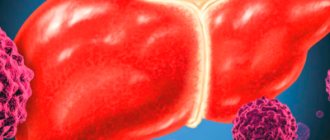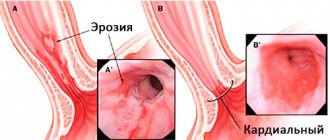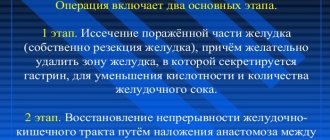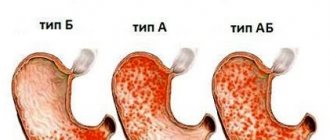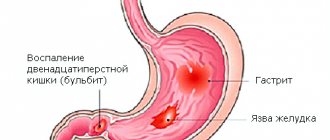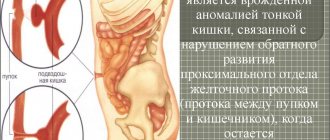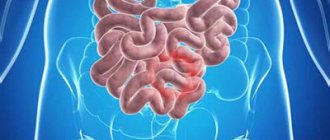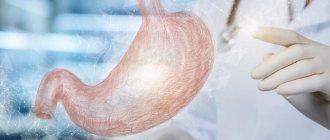Currently, heated discussions continue on the topic of methods of reconstruction of the upper gastrointestinal tract (GIT) both during “standard” and during extended and combined operations for gastric cancer. The sequence of methodological techniques and the safety of surgical techniques are discussed in terms of reliability, functionality and simplicity of the formed anastomosis.
The history of modern gastric surgery dates back to the end of the 19th century, when in 1876 Czerny performed the first gastrectomy on a dog. Another 12 years passed before the first gastrectomy in a person, when in 1883 the American surgeon Conner made this attempt, but the patient died on the operating table. The first successful gastrectomy, which ended with suturing the esophagus with the jejunum, was performed by the Swiss Shlatter in 1897, and already in 1898 Brighman performed a second successful gastrectomy with the formation of an esophagoduodenoanastomosis [1, 2]. Over the past almost one and a half centuries, surgery has made a colossal leap forward from the technical, molecular genetic and many other positions of modern medical science, but esophageal-intestinal anastomosis, like more than a hundred years ago, remains a subject of controversy and painful thoughts for the surgeon.
Many years of experience in operations for gastric cancer have not changed in any way the two main requirements for the esophageal-intestinal anastomosis and the method of reconstruction of the gastrointestinal tract: 1) a minimum number of complications in the immediate postoperative period; 2) good long-term functional indicators, ensuring a high quality of life for operated patients.
All efforts of surgeons are aimed precisely at fulfilling these conditions. Ways to increase the reliability of the anastomosis were sought in multi-stage operations with delayed anastomosis, studies of intraesophageal and intragastric hemodynamics, which led to the development of methods of intraoperative artificial oxygenation. Options for forming additional vascular, arterial and venous microvascular anastomoses have been widely discussed. Sympathectomy was also recommended to eliminate arteriolospasm. Today it is difficult to imagine that in order to preserve the vascularization of the fundus of the stomach, it was supposed to be mobilized together with the tail of the pancreas and the spleen with the displacement of this entire organ complex into the pleural cavity [1]. The evolution of surgery and the accumulation of collective experience have not allowed these methods to stand the test of time. A similar situation has arisen with ideas about the optimal method of forming an esophageal-intestinal anastomosis. Historically, a manual interrupted multi-row suture served as the basis for the formation of this anastomosis. Esophagojejunostomy with a minimum number of sutures has undergone an evolutionary stage from various complex designs and options and has again become considered optimal [2]. Since the late 50s of the last century, various staplers have been used in gastric cancer surgery. The idea of mechanical formation of an anastomosis received a “second wind” in the late 80s of the last century due to the rapid development of laparoscopic surgery throughout the world [5, 8]. Moreover, it would not be an exaggeration to say that the experience of using minimally invasive technologies not only returned the idea of routine hardware reconstruction of the upper gastrointestinal tract to open surgery, but also made it possible to develop options for esophagojejunostomy with linear staplers instead of circular ones with satisfactory immediate and long-term results [6, 7 ].
Reconstruction on a disconnected jejunal loop is one of the simplest. It was described by S. Roux back in 1897 and is almost always feasible. Many different methods of reconstruction have also been proposed with the formation of small intestinal reservoirs and the use of “inserts” from the jejunum in order to restore passage through the duodenum, using the ileocecal valve as an anti-reflux mechanism [4, 10]. Multicenter modern controlled studies have established only a small potential benefit in the quality of life of patients with a good prognosis, their nutritional status, the incidence of dumping syndrome, esophagitis and anastomotic stricture in the long-term period after using various reservoir techniques compared with that after “standard” reconstruction on an isolated loop [4, 10]. Thus, in this aspect of gastric cancer surgery, ideas about the “simplest” option for restoring the continuity of the gastrointestinal tract as the most optimal are currently dominant. What should be the routine method of reconstruction for gastric cancer? Here's our view.
Standard technique for performing upper gastrointestinal reconstruction
The stage of mobilization and lymph node dissection is completed by transecting the esophagus. The first technical point is to place two stay sutures on the side walls of the esophagus 2.5-3 cm above the site of the intended anastomosis. We do not tie ligatures. We apply an instrument to the esophagus to form a purse-string suture using 3/0 prolene thread on a straight needle. We cross the esophagus 5 mm lower, leaving excess mucosa, which coincides with the principles of forming a “universal” esophageal anastomosis manually, developed at the Russian Cancer Research Center. An important technical point is the insertion of straight needles into the device until the intersection of the esophagus and manual control of the absence of a gastric tube in it. Immediately after removing the purse-string suture apparatus, we place the head of the stapler into the lumen of the esophagus, and tie the ligature without additionally wrapping the stylet of the stapler head [9]. After removing the drug in a given volume and suturing the duodenal stump in the isoperistaltic direction, we mobilize a loop of jejunum at a distance of 20-30 cm from the ligament of Treitz, usually at the level of the second arcade. We consider the next mandatory technical technique to be excision of a section of the mesentery of the jejunum over a length of 4-5 cm, which will not only allow for reliable placement of the stapler, but will also provide additional freedom to the mobilized section of the jejunum. We stitch the intestine with a linear apparatus of the UO-40 type closer to its proximal edge. We insert a circular stapler through the intestinal stump, on which Allise clamps are applied, 7-8 cm, open the device and insert a stylet along the antimesenteric edge of the intestine (Fig. 1).
Rice. 1. Scheme of formation of esophagojejunostomy. After forming the anastomosis and removing the apparatus, we hold the intestinal stump with previously applied clamps, stitch it and cross it with a linear apparatus in the area of adequate blood supply. We cover the line of the mechanical seam with a purse-string suture [3].
Despite the manufacturers' assurances of the reliability of the mechanical suture, during open operations we strive to immerse it with separate interrupted sutures. We begin the immersion by stitching the serous membrane of the jejunum with a previously applied stay suture at a distance of 5-7 mm from the mechanical suture line. Next, we suture the anterior wall of the anastomosis with rare sutures. Using a Fedorov clamp, we place the first ligature behind the posterior wall of the anastomosis and, using traction, we unfold the posterior wall of the anastomosis, which greatly facilitates suturing it. The last step is to wrap the anastomosis of the jejunal stump with a separate suture. Then we pass a double-lumen probe below the level of the intestinal Brownian anastomosis. Recently, we have been using nasojejunal intubation primarily for the purpose of early enteral nutrition. In some cases, it is possible to do without installing a probe into the jejunum just for the purpose of decompression.
Our experience included frequent use of reusable circular staplers with disposable cartridges of various diameters. In this case, we have improved the reconstruction technique to reduce operative time and reduce operative trauma (Fig. 2).
Rice. 2. Scheme of formation of hardware entero-enteroanastomosis. To do this, after mobilizing the jejunum for anastomosis, we cross it not with a linear stapler, but with a purse-string suture apparatus. We immerse the head into the distal end and tie the suture. We pass a stapler through the proximal intestinal stump and form an interintestinal anastomosis.
Subsequently, we continue the operation as described above. The described technique is characterized by simplicity, reliability, high reproducibility and speed of execution. In addition, disposable devices for forming a purse-string suture such as Pursting 65 can be used, which makes the reconstruction method even more universal.
Complications after gastric surgery
Complications can be early (develop immediately or shortly after surgery) and late.
Early complications
Peritonitis
Peritonitis is one of the most common complications in gastric surgery and the main cause of postoperative mortality. Most often it develops as a result of suture failure, less often – as a result of ischemic necrosis of the stump of the stomach or duodenum.
Failure of the sutures of the gastrointestinal and gastroduodenal anastomoses
Often the cause of suture dehiscence is gastric resection within the affected tissue.
Infiltrates and abscesses of the abdominal cavity
This is a common complication in gastric surgery. Limited infiltrates and abscesses can develop as a result of infection of the abdominal cavity during surgery or suppuration of hematomas. Much less often, abscesses form in the presence of an inflammatory focus outside the surgical intervention area and the spread of infection through the lymphatic and circulatory tracts.
Postoperative bleeding
One of the serious complications of the early postoperative period after gastrectomy is bleeding into the lumen of the digestive tract and especially into the free abdominal cavity.
Postoperative pancreatitis
Many authors believe that this complication develops mainly due to trauma to the pancreas during surgery. Indeed, during gastrectomy and gastrectomy, the pancreas may be injured at certain stages of the operation.
Intestinal obstruction
Intestinal obstruction is not so common, but a serious complication in the early stages after gastric surgery. The adhesive process in the upper floor of the abdominal cavity, causing deformation, bending, and sometimes compression of the adductor and efferent segments of the small intestine, can contribute to the development of a number of complications.
Violation of evacuation from the stump
The causes of impaired evacuation from the gastric stump are varied. First of all, inhibition of the motor activity of the stump that develops as a result of surgical trauma. Pancreatitis, inflammatory infiltrates and abdominal abscesses also contribute to inhibition of motor activity of the stump. The state of motor function of the stomach before surgery is of great importance in the development of complications. In particular, with pyloric stenosis, accompanied by impaired gastric motility, the likelihood of impaired evacuation from the stump in the postoperative period increases significantly.
Late complications
Operated stomach syndromes are a group of syndromes and diseases united by a single mechanism and developing after surgical interventions on the stomach. Operated stomach syndromes occur in 30–35% of patients after gastrectomy and in 10–15% of patients who have undergone organ-saving surgery. A factor contributing to the occurrence of these syndromes and diseases is a long gastroenterological history, against the background of which the reserve capabilities of the gastrointestinal tract and a certain type of psychological personality are depleted (melancholic or choleric temperament predominates).
- dumping syndrome (early dumping syndrome);
- hypoglycemic syndrome (late dumping syndrome);
- adductor loop syndrome;
- small stomach syndrome;
- reflux gastritis.
The main symptoms are nausea, regurgitation, vomiting, dull pain or heaviness in the upper abdomen.
- Dysphagia is observed relatively rarely after vagotomy in the immediate postoperative period; it is mild and resolves quickly.
- Metabolic disorders.
- Postoperative hernias.
- Anastomotic ulcers.
- Cicatricial narrowing of the anastomosis.
Material and methods
The study included 145 patients with stages I-IV gastric cancer who underwent surgical treatment at the Russian Research Center for Cancer Research from 2002 to 2013. All patients underwent a comprehensive examination at the preoperative stage aimed at verifying and clarifying the extent of gastric cancer. Concomitant diseases were present in 93 (64%) patients. Excess body weight (body mass index more than 25 kg/m2) was noted in 23 (15.7%) patients. The patients were divided into two groups: in group 1 ( n
=71) at the reconstructive stage, an esophageal-intestinal anastomosis was formed manually, in the 2nd group (
n
=74) - an esophageal-intestinal hardware circular anastomosis. In most cases, the anastomosis was formed on an end-to-side loop of jejunum disconnected according to Roux; in two cases, esophagojejunostomy was formed on a loop of jejunum (in one of them, with the creation of a reservoir according to Rodino) and in another observation, esophagojejunostomy was performed. The anastomosis was formed manually using separate interrupted double-row sutures with non-absorbable threads on an atraumatic needle. Among the surgical approaches, median laparotomy predominated - in 54 observations, combined thoradiaphragmolaparotomy access was used in 17 observations. Gastrectomy was performed in 47 cases, gastrectomy with resection of the lower third of the esophagus - in 17 cases. In 7 patients, combined operations with splenectomy, resection of the pancreas or transverse colon were performed. Gastric tumors of stages IIIa-IIIc according to the TNM system prevailed in terms of prevalence - 63 observations. The average duration of the reconstructive stage of the operation in this group was 72±21.9 minutes.
To apply mechanical sutures, circular staplers from four different manufacturers were used. All anastomoses were performed on a Roux-enhanced loop of jejunum. The technique for forming the anastomosis is described in detail above. Among surgical approaches in this group of patients, median laparotomy also predominated - 59 observations. The remaining operations were performed using a combined thoracodiaphragmolaparotomy access in the sixth intercostal space on the left. Isolated gastrectomy was performed in 49 patients, combined operations with resection of the esophagus and/or adjacent organs - in 26 cases. The prevalence of gastric cancer and general characteristics of patients are presented in Table. 1.
Table 1. General characteristics of observations
A number of complications arose in the immediate postoperative period (Table 2).
Table 2. Complications in the immediate postoperative period Complications directly related to the method of anastomosis formation (its failure) were noted in one patient of the 1st group and in two patients of the 2nd group. However, if relaparotomy was required in case of failure of manual anastomosis, then when using a mechanical suture, patients were treated conservatively with implantation of an esophageal stent and in both cases there was no death.
69 (47.6%) patients were followed up for a period of 1 to 10 years. Complications potentially associated with the technique of formation of esophagojejunostomy were studied (Table 3).
Table 3. Long-term complications
Therapeutic nutrition for post-gastroresection syndrome
29.08.13
Medical nutrition for patients who have undergone partial gastrectomy . After gastric resection for peptic ulcer of the stomach and duodenum, post-gastroresection disorders often develop. The most commonly observed is dumping syndrome.
With dumping syndrome, due to a breakdown in neurohumoral regulation, the coordinated and synchronous activity of the gastrointestinal tract organs is disrupted. If in this case there are functional disorders of the liver and pancreas, a decrease in the enzymatic activity of the mucous membrane of the small intestine, a decrease in the acid-producing function of the gastric stump, then dumping syndrome may be accompanied by disturbances in the digestion and absorption of nutrients. Patients experience asthenia, weight loss, anemia, hypovitaminosis, as well as changes in neuropsychic status.
When dietary therapy of these patients, the period after surgery, the severity of dumping syndrome, the nature of concomitant diseases and the consequences of reconstructive operations are taken into account. Its main principle is to prescribe high-protein nutrition in fractional portions. The protein content is increased to 2-2.2 g per 1 kg of body weight. The content of fat and carbohydrates is kept within normal limits, the amount of easily digestible carbohydrates is significantly limited.
After partial resection of the stomach, the secretion of gastric enzymes - pepsin and gastricsin - is significantly disrupted, which can lead to disturbances in protein digestion. Considering this factor, it is necessary to include crushed protein dishes in the diet of patients, which are easier to digest and are attacked by enzymes of the pancreas and small intestine.
In the very first days after surgery, when you can start feeding the patient, protein dishes are included in the diet; protein enpit is introduced.
Prescribing an increased amount of protein in the early postoperative period is necessary due to the large loss of protein during surgery and the tendency of patients to catabolic processes.
An increased content of protein-rich foods in the diet provides the body with a sufficient amount of fat. Patients after gastric resection tolerate the fat contained in these products well. With concomitant pancreatitis, the amount of fat is reduced to the lower limit of normal.
Recommendations to increase the fat content in the diet of patients after gastrectomy to the upper limit of normal are due to the biologically important properties of fats, which include fat-soluble vitamins, lipotropic substances, and essential fatty acids. Due to frequent complications from the biliary tract and gallbladder, patients should not overuse fats. Refractory fats and fat breakdown products formed during frying are excluded. The content of complex carbohydrates should be within the lower limit of normal (for patients with severe dumping syndrome, no more than 300g per day). In addition, the diet should contain nutritional factors that stimulate hematopoiesis. It is important to ensure, in particular, a sufficient intake of iron from food.
In the first 2-4 months. After surgery, due to the postoperative inflammatory process, it is recommended to follow the principle of mechanical sparing. At a later date, food should also be mechanically gentle in the presence of peptic ulcers, pancreatitis, anastomositis, enteritis. In all other cases, it is necessary to give unprocessed food, since it is better tolerated by patients with dumping syndrome, and its absorption differs little from the absorption of pureed food.
The amount of liquid is limited, since it is liquid food that mainly causes dumping syndrome.
Taking into account changes in the hepatobiliary system, small intestine, pancreas, gastric stump, anastomosis, when preparing a diet for patients after gastrectomy, the principle of moderate chemical sparing is used, i.e., chemical irritants of the gastrointestinal tract and sharp secretion stimulants are excluded.
For operated patients with underweight, it is planned to increase the energy value of the diet.
When preparing a therapeutic diet, exclude dishes and products that provoke the occurrence of dumping syndrome.
For patients with peptic ulcer disease who have undergone gastrectomy, several diet options are offered: with mechanical sparing, without mechanical sparing, in severe forms of dumping syndrome, for patients with concomitant pancreatitis, in the early postoperative period, etc.
Medical nutrition in the first days after gastrectomy . Nutrition is based on the principle of gradually increasing the load on the gastrointestinal tract and including a sufficient amount of protein in order to restore the functions of the digestive organs.
During the first day after surgery, patients are not given any food. On the 2-3rd day, if you feel well and there are no clinical signs of food retention in the stomach, tea with a small amount of sugar, rosehip decoction, low-sweet compote and jelly (mashed), 25% protein enpit 30-50 ml 2 times a day are prescribed.
On the 4-5th day, you can include soft-boiled eggs, slimy soups, meat and cottage cheese puree and soufflé in your diet. Number of meals – 5-6 times a day in a volume of 70-100 ml per meal.
On the 6-7th day, the diet is expanded, the portion of protein and other dishes is increased, pureed porridge (preferably oatmeal, bread and rice), and white crackers are added (on the 8th day). By the 10th day, the volume and chemical composition of the diet is closer to normal. Include pureed vegetable dishes (potato, carrot puree). Meat and fish dishes are served in the form of steam soufflés, quenelles and meatballs. They recommend soft-boiled eggs, steam omelettes, and curd soufflé. Food is consumed 5-6 times a day in the amount of 200-400 ml per dose. With each meal, the patient should receive a protein dish.
Diet option with mechanical sparing for patients who have undergone gastrectomy . Indications for use and purpose of the diet. The diet is prescribed to patients after 10 days - 2 weeks. after surgery for 2-4 months. It can also be recommended for a longer period of time in the presence of diseases of the operated stomach (gastritis, anastomositis, peptic ulcer, enterocolitis).
The diet helps reduce inflammation in the gastrointestinal tract, stimulates reparative processes, and also prevents the occurrence of dumping syndrome.
General characteristics of the diet. The diet is physiologically complete, with a high protein content, a normal content of complex carbohydrates and a sharp limitation of easily digestible carbohydrates, and a normal fat content. It limits the content of mechanical and chemical irritants of the mucous membrane and the receptor apparatus of the gastrointestinal tract, the content of nitrogenous extractive substances (especially purines), refractory fats, fat breakdown products that arise during frying (aldehydes, acroleins) is maximally reduced. Strong stimulants of bile secretion and pancreatic secretion are excluded, as well as foods and dishes that can cause dumping syndrome (sweet liquid milk porridges, sweet milk, sweet tea, hot fatty soup, etc.). The diet is hyposodium.
In case of pronounced dumping syndrome, it is recommended to take the liquid and solid parts of the diet separately: the liquid is consumed 30 minutes after eating a solid meal; during lunch, it is recommended to eat the second course first, and then the first. It is recommended to eat food while lying in bed.
Culinary processing. All dishes are prepared boiled or steamed, pureed.
Chemical composition. Proteins 110-120g, fats 100g, carbohydrates 380g. Table salt 6-8g. Energy value 2800-3000 kcal.
The diet is split (5-6 times a day).
Food temperature 40-38°C. Avoid hot and cold foods.
List of recommended products and dishes.
Bread and bakery products. Day-old wheat bread, wheat bread crackers, unsweetened cookies.
Soups. On vegetable (excluding white cabbage), cereal decoctions, pureed, low-fat meat broth once a week.
Meat and fish dishes. Lean meat without tendons (beef, chicken, veal) and fish (cod, pike perch, carp, pike, bream, navaga, silver hake, carp) in chopped form (mashed potatoes, soufflé, dumplings, meatballs, rolls, cutlets). These products are boiled, steamed, baked (with preliminary boiling).
Egg dishes. Soft-boiled eggs (no more than one per day), white omelette or one whole egg.
Milk, dairy products and dishes made from them. Milk in dishes and for tea, if tolerated - whole milk. Kefir is allowed after 2 months. after operation. Sour cream is used only as a seasoning. Non-sour cottage cheese, freshly prepared, pureed.
Vegetable dishes and side dishes. Boiled and pureed vegetables. Boiled cauliflower with butter, stewed zucchini and pumpkin, carrot and mashed potatoes.
Fruits, berries, sweets. Fruits and berries (fresh and dry) in the form of unsweetened pureed compotes, jelly, jellies, mousses. Baked apples without sugar. Fruits and berries with coarse fiber (pear, quince) are not allowed. Honey, sweets, and jam are sharply limited.
Dishes and side dishes from cereals, pasta. Unsweetened, pureed, viscous porridges, puddings, casseroles made from rice, whole grains, rolled oats. Semolina is limited. Finely chopped pasta, boiled.
Fats. Butter, ghee, olive, and refined sunflower oil are added to dishes in their natural form.
Snacks. Mild cheese (Yaroslavl, Russian, Uglich) grated, pressed, granular caviar, homemade meat pate, boiled meat jelly with the addition of gelatin.
Sauces and spices. Sauces based on vegetable broth, sour cream.
Drinks and juices. Weak tea and coffee with and without milk. Unsweetened fruit juices (except grape), berry and vegetable juices. Decoctions of rose hips.
Prohibited: products made from butter and hot dough, brains, liver, kidneys, various pickles and smoked foods, marinades, canned meat, fish and other snack foods, smoked sausage, cold and carbonated drinks, chocolate, cocoa, ice cream, alcohol, white cabbage, legumes , mushrooms, spinach, sorrel, radishes, rutabaga, onions, garlic, spices.
Indications for prescribing the diet. In 2-4 months. and more after gastrectomy with mild and moderate forms of dumping syndrome, in the presence of complications of cholecystitis and hepatitis.
Special purpose. Prevent and reduce the manifestation of the dumping reaction, contribute to the normalization of the functional state of the liver and biliary tract.
General characteristics of the diet. The diet is physiologically complete, with a high content of proteins and fats and a normal level of complex carbohydrates with a sharp limitation of simple carbohydrates, with a normal salt content, mechanically not sparing, with a moderate limitation of chemical irritants of the mucous membrane of the gastrointestinal tract, with the exception of strong stimulants of bile secretion and pancreatic secretion glands, with the exclusion and limitation of foods and dishes that cause the development of dumping syndrome.
Culinary processing. All dishes are prepared boiled or steamed and served unpoured. Individual baked dishes without a rough crust are allowed.
Chemical composition. Proteins 110-120g, fats 100-110g, carbohydrates 350g. Table salt 8-10g. Energy value is about 2770-2900 kcal.
The diet is split (5-6 times a day).
Food temperature. Food is given warm; Hot and cold foods should be avoided.
List of recommended products and dishes.
Bread and bakery products. Day-old gray wheat bread, savory and unsweetened varieties of bakery products and cookies. Rye seeded bread.
Soups. On vegetable broths, cereals, vegetarian, borscht, cabbage soup, beetroot soup made from fresh cabbage. Soup with low-fat meat broth once a week.
Meat and fish dishes. Various products made from lean beef, veal, chicken, rabbit, lean fish (cod, pike perch, carp, navaga, pike, carp, etc.) are boiled, baked, stewed, or not chopped.
Egg dishes. Soft-boiled eggs (no more than one per day), white omelet.
Dishes and side dishes from cereals, pasta. Crumbly and viscous porridges, puddings, casseroles from cereals - unsweetened; boiled pasta in the form of casseroles. Buckwheat, rolled oats and rice porridges are recommended. Semolina is limited.
Vegetable dishes and side dishes. Vegetables raw, boiled, baked, stewed. Non-acidic sauerkraut is allowed. Boiled cauliflower with butter, stewed zucchini and pumpkin, salads, vinaigrettes, green peas. Tomatoes with vegetable oil. Early raw finely chopped greens can be added to various dishes.
Fruits, berries, sweet dishes, sweets. In their raw form, they are not very sweet fruits and berries. Compotes, jelly, mousses, unsweetened or prepared with xylitol (10-15g per serving). Limit grape juice, which causes bloating. Honey, sweets, jam are sharply limited. Sugar is given to the patient's hands.
Milk, dairy products and dishes made from them. Milk with tea and other drinks or as part of various dishes, if tolerated - whole milk, curdled milk, kefir, acidophilus milk. Sour cream is used as a seasoning and added to salads. The cottage cheese is not sour, fresh.
Fats. Butter, ghee, olive, sunflower.
Snacks. Mild cheese, low-fat herring, doctor's sausage, homemade meat pate, ham without lard. Salads, vinaigrettes, jellied fish with gelatin, jelly with gelatin.
Sauces and spices. Sauces based on vegetable broth, sour cream. Onions and green onions in limited quantities.
Drinks and juices. Weak tea and coffee with and without milk. Unsweetened fruit, berry and vegetable juices. Rose hip decoction.
The same foods and dishes are prohibited as with the pureed version of the diet (except for white cabbage).
Methods of using therapeutic nutrition . In the first days after gastrectomy, the patient is prescribed a special diet (see Medical nutrition for post-gastroresection syndrome). In 1-2 weeks. in the absence of complications, a special diet can be prescribed (see Diet option with mechanical sparing for patients who have undergone gastrectomy). In the first days of using the diet option consisting of pureed dishes, no more than 1-2 dishes are given per meal, and side dishes are limited. Then they gradually switch to a full ration of pureed diet.
In 2-4 months. (for some patients after 4-5 months) it is recommended to gradually switch to eating unprocessed food (see Diet option without mechanical sparing for patients who have undergone gastrectomy). In the first days, raw vegetables are given in limited quantities, including them in the first course. It is recommended to include black bread, sauerkraut, and salads later, also gradually. If a patient is diagnosed with anastomositis or a peptic ulcer of any location, then a diet consisting of pureed dishes is prescribed.
For patients after gastrectomy, in whom the clinical picture is dominated by symptoms of pancreatitis, a diet of pureed food with a slight reduction in fat content is offered. In severe cases of dumping syndrome, a diet without mechanical sparing is prescribed, with complex carbohydrates limited to 300 g per day and the complete exclusion of simple carbohydrates. All dishes are prepared boiled or steamed. This diet option involves the complete elimination of sugar, a reduction in the amount of food taken per meal (due to side dishes), more frequent meals, it is recommended to eat while lying down and stay in bed for 20-60 minutes after each meal. Chemical composition of the diet: proteins 120g, fats 80g, carbohydrates 350g. Energy value 2620 kcal.
If inflammatory phenomena (enteritis, colitis, perivisceritis) come to the fore in the clinical picture of the disease, then a diet consisting of pureed dishes is used, but with a sharper restriction of carbohydrates, mainly easily digestible ones: sugar is excluded, the number of side dishes is reduced, and salt is limited.
When dumping syndrome is complicated by enteritis or intestinal dyskinesia, a diet is used depending on the nature of the disease. In case of exacerbation of enteritis, a diet consisting of pureed food with the exception of white cabbage, beets, turnips, radishes, radishes, sorrel, spinach, onions, garlic, mushrooms, millet and pearl barley, melons, apricots and plums is prescribed.
For colitis with a tendency to constipation and flatulence, a diet of unprocessed food is given. Ripe tomatoes and leafy lettuce are allowed in their raw form. Exclude brown bread, turnips, radishes, radishes, sorrel, spinach, onions, garlic, mushrooms. Fruits are allowed without peel. Milk is consumed if well tolerated, preferably diluted. It is recommended to introduce an increased amount of food stimulants of peristalsis (cream, vegetable oil added to dishes, vegetable juices, vegetables and fruits, bran bread, fermented milk products).
After 6-12 months. after surgery, in the absence of complications from the liver, pancreas and intestines, it is recommended to switch to a physiologically complete diet with normal culinary processing (diet No. 15). However, in this case, the patient must adhere to the principle of fractional meals and limiting dishes that provoke dumping syndrome.
The transition to a more varied diet is carried out in these patients by reducing the degree of mechanical sparing, while chemical sparing lasts longer due to persistent disorders of the secretion of the digestive glands.
For patients who have undergone gastrectomy without subsequent complications, split meals 4-5 times a day are recommended, limiting foods and dishes that most often cause dumping syndrome (sweets, sweet milk porridges, very hot and cold dishes). Food should be taken slowly, chewing it thoroughly.
Therapeutic nutrition for patients who have undergone total gastrectomy . Patients operated on for stomach cancer must be prescribed a complete diet with a limited amount of simple carbohydrates, foods containing animal fat, cholesterol and with an increase in vegetable oil, buckwheat, and sago.
Observations in recent years have shown that patients operated on for stomach cancer quite often experience complications from other digestive organs (pancreatitis, cholecystitis, enteritis, colitis). It is known that patients with organic lesions of the stomach already at the time of surgery have significant impairments in the functional state of the digestive organs and metabolic processes. Therefore, after surgery, as a rule, complications arise from other digestive organs. This circumstance poses the task of gastroenterologists to create a diet for patients who have undergone surgery for stomach cancer, taking into account the existing complications.
Patients after gastrectomy who have complications from other digestive organs can be recommended the same diet options as for patients who have undergone partial gastrectomy, with a slightly reduced energy value and limited animal fat.
The general principles of nutrition for patients after total gastrectomy are:
balanced therapeutic nutrition with sufficient protein content;
limiting easily digestible carbohydrates (sugar, honey, jam) and animal fats;
taking into account the nature of complications arising after surgery.
After gastrectomy in the first 1-2 months. A diet of pureed dishes is recommended, then you can switch to the option of unprocessed dishes (see above). In the long term after surgery, patients after total removal of the stomach who have concomitant pancreatitis are better prescribed a diet of pureed dishes. Often, patients after gastrectomy experience various types of intestinal dyskinesia. If you are prone to diarrhea, give apples baked or raw without peel, excluding milk and sugar.
For constipation, you can add vegetable juices, prune decoction, tea with milk, vegetable oil to porridges, vegetables, soups to the unpurified diet; boiled beets. In the absence of complications from the digestive system, a diet of unprocessed dishes with normal culinary processing is prescribed.
Patients operated on for stomach cancer are recommended to limit the amount of fat and, if possible, include low-fat foods (low-fat cottage cheese, milk, lean meat, etc.).
Diet option for patients after total removal of the stomach and complications from the digestive organs after 1.5-3 months . After operation. General characteristics of the diet. The diet is physiologically complete, with a high protein content, with a limitation of fat and complex carbohydrates to the lower limit of the norm and a sharp limitation of easily digestible carbohydrates, with a moderate limitation of chemical irritants of the gastrointestinal tract. Exclude stimulants of bile secretion and pancreatic secretion. The diet is hyposodium.
Culinary processing. All dishes are prepared boiled or steamed; frying is not allowed. Food is given unprocessed. Dishes can be baked after preliminary boiling or stewed, removing the first portion of the juice released during stewing.
Chemical composition of the diet. Proteins 110-120g, fats 80-90g, carbohydrates 330g. Table salt up to 8g. Energy value 2500-2900 kcal.
The diet is split (5-6 times a day).
The range of foods and dishes in the diet does not differ significantly from that in the diet for patients with severe dumping syndrome. It includes protein products - lean meat, fish, cottage cheese. Oil is added only to dishes.
The same foods are prohibited as in the diet for patients after partial gastrectomy.
